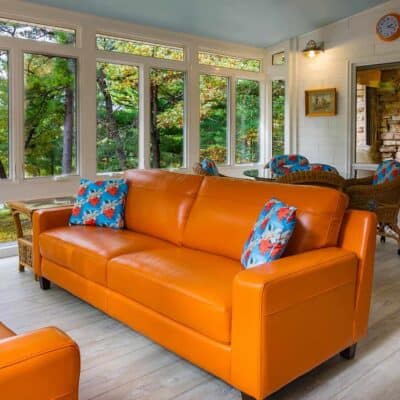 From an aesthetic point of view, there appears to be little difference between a 3-season and all-season room. Upon closer inspection, you’ll find that although the look is very similar there are some major differences — mostly in the materials used, including the framing system and the type of glass.
From an aesthetic point of view, there appears to be little difference between a 3-season and all-season room. Upon closer inspection, you’ll find that although the look is very similar there are some major differences — mostly in the materials used, including the framing system and the type of glass.
That said, both room types have the ability to keep the room heated and cooled. We mention this because people are sometimes more focused on staying warm in the cooler months, and are pleasantly surprised to learn that these rooms can keep you cooler in the warmer months, too!
What sets these two types of rooms apart is the amount of usage you will get from each.
A 3-season room is built with single-pane glass and non-insulated floors. We build them to last and look great for years to come, they’re just not suitable for Wisconsin winters. The reason is, single-pane glass and non-insulated floors don’t offer the same amount of climate control as the materials used in an all-season room. 3-season rooms are also built with non thermally-engineered frames that are extremely sturdy, but do not provide the same climate control benefits of the thermally-engineered frames found in all-season rooms.
Because of this, a 3-season room is an excellent choice if you’re not concerned with using your room during the coldest times of the year. It’s less expensive than an all-season room, just as lovely and equally well constructed.
It comes down to a question of usage vs. cost, which is something we discuss with our clients so they can make the best decision possible. The last thing we want a homeowner to do is spend too much for a room they don’t plan on using year round, or spending less only to regret not having the use of their room when the temperature drops.
TYPICAL USAGE: 3-season rooms are typically used in the spring, summer and fall.
An all-season room uses framing that is thermally engineered so the room can be cost-effectively heated and cooled year round. Use of double-pane glass and insulated floors are also major factors in creating a room that can be temperature controlled. In other words, an all-season room lets you effectively use an HVAC unit for either heating or cooling purposes — creating year-round comfort.
All-season rooms have two available options for framing:
- Vinyl with steel and aluminum reinforcement
- All aluminum
Both of these framing options are thermally-engineered.
Ultimately, if you want to be close to nature and the beauty of winter, without having to deal with the cold, an all-season room is an excellent choice.
When it comes to cost, all-season rooms tend to be more expensive than 3-season rooms because of the materials used.
TYPICAL USAGE: All-season rooms are built for year-round use, even during our frigid Dane County winters.
One final note: in case you were wondering, 3-season rooms can be upgraded to all-season rooms!
Want to learn more?
Feel free to check out our 3-season & all-season rooms page. You can also contact us anytime with questions or to set up an appointment to discuss things further.